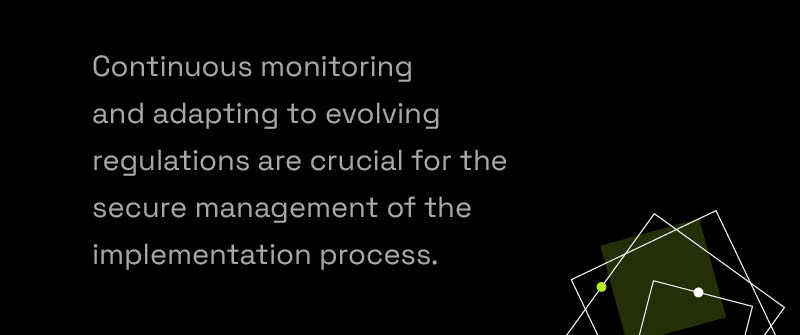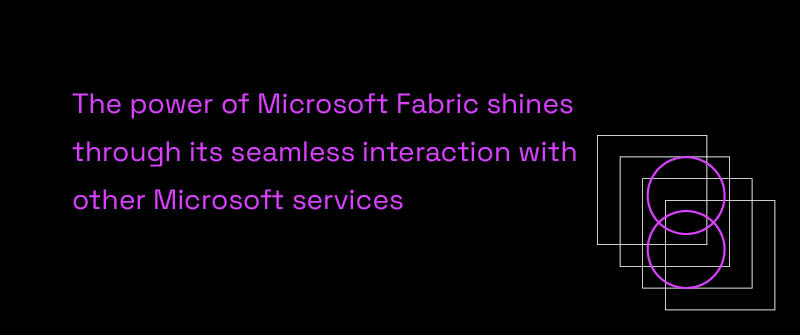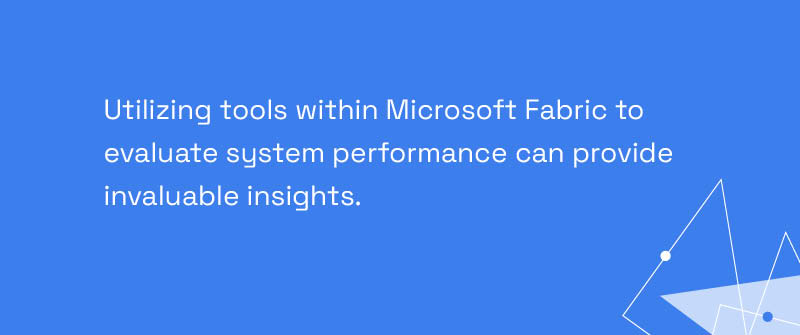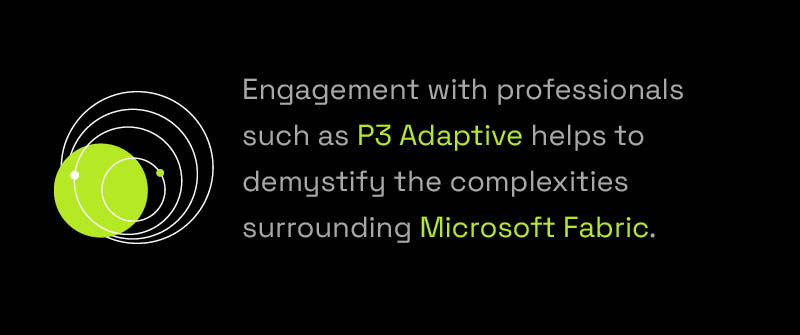
What Are the Challenges of a Microsoft Fabric Implementation?
Implementing Microsoft Fabric can present several unique challenges, but awareness and strategic planning, often with the help of Microsoft Fabric Consulting, can help overcome these hurdles effectively. Primarily, these challenges center around understanding its complex architecture, ensuring seamless integration with existing systems, scalability, managing deployment environments, and guaranteeing data security and compliance.
How to Overcome Common Microsoft Fabric Implementation Challenges in Understanding Complex Architecture
Microsoft Fabric’s microservices-based architecture can appear as a daunting task due to its intricate components that demand a thorough understanding and precise configuration. Business leaders and IT professionals must be prepared to invest time in comprehending how these architectural elements interconnect and influence overall system performance.
Integration with Existing Systems
Another significant challenge lies in data integration when incorporating Microsoft Fabric with an organization’s existing infrastructure. Aligning new technology with old systems requires a methodical approach to ensure data consistency and minimize disruptions in operations.
Scalability Concerns
While Microsoft Fabric offers extensive scalability potential, configuring this effectively poses a challenge. Planning for unforeseen peaks in demand and ensuring the infrastructure can cope without degrading performance or encountering performance issues requires strategic foresight and robust configurations.
Managing Deployment Environments
Deployments across on-premise, cloud, or hybrid environments demand understanding the governing processes for each, alongside managing the transition seamlessly. Deployment must be managed meticulously to avoid pitfalls related to compatibility and consistency across varied environments.
Ensuring Data Security and Compliance
Amidst increasing data security concerns and stringent compliance requirements, ensuring that Microsoft Fabric meets these expectations entails prioritizing data quality alongside robust security protocols and compliance frameworks. Continuous monitoring and adapting to evolving regulations are crucial for the secure management of the implementation process.
P3 Adaptive is adept at addressing these implementation challenges head-on, offering tailored solutions and expert guidance to streamline deployment and ensure that business objectives align seamlessly with technology adoption.

How to Address Microsoft Fabric’s Complex Architecture
Managing the complexity of Microsoft Fabric architecture requires a strategic approach focused on understanding, compartmentalizing, and leveraging expert resources. Microsoft’s platform is built on microservices architecture, which inherently offers modularity but can introduce complexity in its deployment and management. By integrating data engineering, data science, and business intelligence, and breaking down the architecture into smaller components, businesses can more effectively manage the system’s intricacies.
Break Down Architecture into Smaller Components
Start by deconstructing the larger architecture into manageable components of Microsoft Fabric. This modular approach aligns with the principles of microservices architecture, where each service can operate independently but collectively forms a cohesive system. By incorporating data engineering, it becomes easier to focus on key functional areas, troubleshoot specific issues, and allow for iterative improvements over time without overhauling the entire system.
Utilize Available Tutorials and Guides
The wealth of accessible tutorials, extensive documentation, and guides available, both through Microsoft and independent tech communities, provides invaluable information for mastering Microsoft Fabric. These resources often include step-by-step instructions and practical examples to help bridge the knowledge gap, making it easier for IT professionals and business leaders to implement these solutions effectively.
Leverage Community and Professional Networking
Engaging with professional networks and online communities can be instrumental for users navigating the complexities of Microsoft Fabric. Forums, user groups, and social media communities often host lively discussions that can offer fresh insights and solutions to common challenges.
Consult with Experts Like P3 Adaptive
For comprehensive guidance tailored to your business’s specific needs, consulting with experts like P3 Adaptive can provide strategic value and clarity. Their experience in technology solutions can simplify the process, enhance efficiency, and maximize the potential benefits of Microsoft Fabric for your business. Leveraging these consultations can ensure that your deployment is not just functional but strategically aligned with broader business goals and meets the needs of your customers.
Integrating Microsoft Fabric with Existing Systems
Successfully integrating Microsoft Fabric with your existing systems and business intelligence is key to maximizing its benefits. Essentially, this requires a strategic approach to identify key integration points, utilize compatible services, facilitate seamless data exchange, and foster cross-departmental collaboration. When done right, this integration can significantly enhance operational efficiency and drive more insightful decision-making processes within your organization.
Identify Key Integration Points
Before diving into the technical integration, it’s crucial to understand which systems and data sources are pivotal for your operations, particularly in the context of data workflows. Map out your current infrastructure and pinpoint where Microsoft Fabric can add the most value. By focusing on integration points that support business-critical processes, you ensure that Fabric enhances rather than disrupts your existing workflows.
Utilize Microsoft Services like Azure
The power of Microsoft Fabric shines through its seamless interaction with other Microsoft services, such as Azure. Leverage Azure’s cloud capabilities, including Azure Synapse, to create a robust connection between Fabric and your existing on-premises or cloud solutions. This not only fosters a smoother data interchange but also capitalizes on Microsoft’s comprehensive suite of productivity and analytics tools, driving greater business productivity.

Plan for Seamless Data Exchange
Ensuring that data flows uninterrupted between systems is crucial for effective integration. Implement protocols that allow for real-time data sharing and processing. This ensures that information is always up-to-date and readily available for analysis. Consider leveraging Microsoft’s Dynamics 365 to create a centralized hub for data gathering and dissemination, enhancing your organization’s ability to draw actionable insights promptly with real time analytics.
Facilitate Collaboration Across Teams
Integration isn’t just a technological endeavor; it’s also a collaborative one. Encourage collaboration between technical teams, operations staff, and business units. By fostering a culture of cooperation, you create an environment where insights flow freely and solutions are co-created, thereby driving innovation and improvement across the board. Communication is key, and setting up regular inter-departmental meetings or workshops can help in ironing out any integration challenges that arise and in developing the necessary skills.
Scalability and Deployment Solutions for Microsoft Fabric
Scalability is a critical feature of Microsoft Fabric that allows it to handle increasing workloads without sacrificing performance. This capability is essential for businesses aiming to expand their operations and data capacity. Ensuring scalability involves a multifaceted approach where proper planning, system architecture, and ongoing performance assessments play vital roles. Selecting the most efficient solutions is crucial to optimize scalability and deployment processes.
Plan for Dynamic Scalability
Dynamic scalability in cloud deployment ensures that resources are allocated according to the application’s needs. This requires planning from the development stage, where projected growth in data volume is matched with infrastructure capabilities. Organizations must decide on the appropriate Microsoft Fabric capacities based on their current and anticipated data needs while also taking into account fluctuating demand and peak usage periods. Adjustments can be made over time, allowing businesses to optimize costs and performance.
Implement Fault-Tolerant Systems
Incorporating fault tolerance into your deployment ensures that your systems remain reliable under diverse conditions. Microsoft Fabric is designed with robust fault-tolerant capabilities, which monitor systems and automatically recover from component failures. This is crucial in maintaining uninterrupted service and minimizing the risks associated with downtime. Business leaders should focus on leveraging these features through thorough testing and regular maintenance schedules, ensuring the integrity and continuity of operations while minimizing errors.
Adapt to On-Premises and Cloud Solutions
One of the strengths of Microsoft Fabric is its flexible software, enabling businesses to deploy solutions either on-premises, in the cloud, or through a hybrid approach. This flexibility allows for tailored solutions that align with strategic goals and operational requirements. Decision-makers can determine the most effective deployment strategy by considering factors such as data sensitivity, cost considerations, and existing infrastructure.
Monitor and Adjust for Performance Metrics
Regularly monitoring performance metrics is vital to identifying scalability issues and ensuring optimal operation. Utilizing tools within Microsoft Fabric to evaluate system performance can provide invaluable insights into data processing speeds, latency, and throughput limitations. By establishing benchmarks and regularly reviewing them against operational performance, organizations can quickly identify areas requiring adjustment, thus safeguarding against potential bottlenecks and efficiency losses.

For businesses looking to maximize the strategic value of their technology investments, partnering with consulting firms like P3 Adaptive can offer the expertise necessary to navigate the complexities of scalability and deployment effectively. Their knowledgeable guidance can empower IT professionals and business leaders to make informed, strategic decisions that align with long-term business objectives. Effective optimization of workflows, cost efficiency, and performance within Microsoft Fabric and Power BI is crucial to managing resources effectively and improving overall system performance.
Ensuring Data Security and Compliance with Microsoft Fabric
Addressing data security and compliance in Microsoft Fabric is crucial for protecting your business’s sensitive data. By leveraging Microsoft Purview and the comprehensive security frameworks provided by Microsoft, such as Azure’s robust security features, organizations can ensure their data remains secure and compliant with international standards. Regularly updating compliance protocols and implementing disaster recovery plans are vital steps toward safeguarding enterprise data effectively.
Leverage Microsoft Security Frameworks
Microsoft Fabric offers a robust set of security features that align with Azure’s frameworks. These include encryption at rest and in transit, role-based access controls, and network security. By utilizing these features, businesses can establish a secure environment, minimizing the risk of unauthorized access and breaches. Companies can confidently integrate Microsoft Fabric into their existing systems, knowing that it conforms to high security standards, such as GDPR, HIPAA, and SOC certifications.
Regularly Update Compliance Protocols
The ever-evolving landscape of data regulation requires businesses to keep their compliance protocols up to date. Additionally, Microsoft Fabric’s integration with Azure ensures automatic updates and compliance adjustments, keeping your data security measures aligned with the latest industry standards. This proactive approach helps organization leaders maintain compliance and avoid potential penalties that could arise from regulatory breaches.
Implement Robust Disaster Recovery Plans
Having a sound disaster recovery plan is essential for ensuring data integrity and business continuity. Microsoft Fabric empowers organizations with advanced backup solutions and recovery strategies, minimizing downtime and data loss in the event of a disaster. This seamless integration of backup solutions guarantees that businesses can quickly resume operations while maintaining data integrity.
Educate Teams on Security Best Practices
While technology solutions provide substantial security enhancements, fostering a culture of security awareness among your workforce is equally important. Educating your teams on security best practices, including recognizing phishing attempts and securing login information, can further protect your organization from breaches. Conduct regular training sessions and refresh your team’s knowledge about the latest security threats and how to mitigate them.
By addressing data security and compliance, organizations can confidently use Microsoft Fabric to unlock new efficiencies without placing their sensitive information at risk. Consulting with experts like P3 Adaptive ensures that these security measures are not just implemented but also optimized to align with your unique business goals.
Conclusion: Maximizing Success with Microsoft Fabric
Successfully implementing Microsoft Fabric requires strategic planning, continuous learning, and an alignment of technology with business goals. By paying attention to these key areas, organizations can not only overcome implementation challenges but also capitalize on the full potential of Microsoft Fabric. Continuous adaptation and leveraging expert guidance play a fundamental role in sustaining the success of your implementation.
Importance of Ongoing Learning and Adaptation
In a landscape where technologies are rapidly evolving, ongoing learning and adaptation become indispensable. Microsoft Fabric is a powerful, dynamic platform, and keeping up with its updates can significantly enhance its utility. Allocating resources to training allows your team to effectively utilize new features, integrate improvements into daily operations, and remain competitive.
Engaging with Professionals for Guidance
Engagement with professionals such as P3 Adaptive helps to demystify the complexities surrounding Microsoft Fabric. Expert consultants provide nuanced understanding and strategic insights tailored to your business’s unique needs. Their guidance ensures that obstacles are preemptively tackled and solutions are optimized for superior performance by setting the right example.

Aligning Implementation with Business Objectives
Aligning your Microsoft Fabric implementation with overarching business objectives ensures that technology initiatives are not pursued in a vacuum but are instead purpose-driven, directly impacting efficiency, innovation, and growth. Establishing clear goals and metrics for your platform’s integration can deliver tangible benefits, better aligning with your organizational objectives.
Planning for Long-Term Technology Evolution
Part of embracing Microsoft Fabric’s potential means planning for the long term. In this post, a visionary approach that incorporates future expansions, scalability, and adaptability will smooth out transitions and ensure your technology infrastructure supports your organization’s growth ambitions.
Partnering with P3 Adaptive can exponentially enhance the success rate of your Microsoft Fabric projects. Engage with a seasoned team that specializes in weaving cutting-edge analytics into strategic frameworks. P3 Adaptive takes the complexity out of implementation, allowing your business leaders and IT professionals to focus on what truly matters—driving success and innovation. Contact P3 Adaptive and unlock unprecedented performance enhancement, ensuring your Microsoft Fabric journey is seamless, scalable, and always aligned with your business goals.
Get in touch with a P3 team member